by Editor | Jun 15, 2009 | Luxury Travel
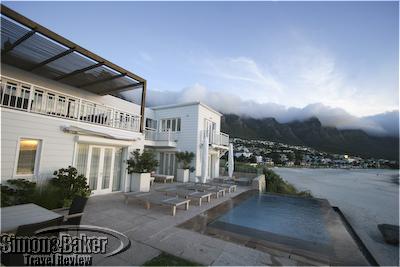
An exterior view of Rock House Villa

Rock House Villa
Looking for a little rest and relaxation in the Cape Town area? We found two multi-million dollar luxury rental properties each with its own distinctive charms. Rock House Villa, a recently constructed luxury four bedroom rental home, hugs a popular South African beach. The two-story house with a live-in staff person is perched on the edge of the rocks of Camps Bay, Cape Town’s famous beach suburb.
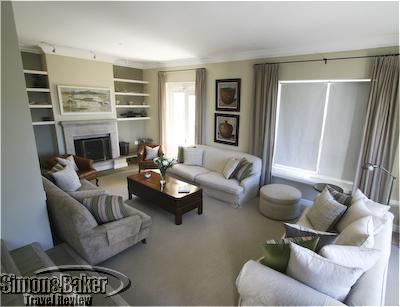
The living room at Villa Higgovale
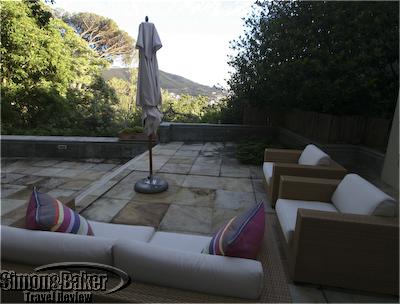
The back deck at Villa Higgovale
Villa Higgovale, a 4,000 square meter property, sits in a residential hillside neighborhood and has a splendid view of Cape Town and its bay. Two full time employees, a housekeeper and a gardener, looked after the six bedroom house which is minutes away from shopping and the city.
Click here to find out what our team discovered during their stay about Rock House Villa and Villa Higgovale.
by Editor | May 4, 2009 | Luxury Travel, New Articles
By Elena del Valle

Love at the Mirage
Photos: Cirque du Soleil Love
During a trip to Las Vegas late last year we had an opportunity to see several shows. Our favorite was Love, a mix of Beatles music and Cirque du Soleil magic. The 90-minute performance in the 2,013-seat theater at The Mirage was a fun way to spend an evening in Sin City.
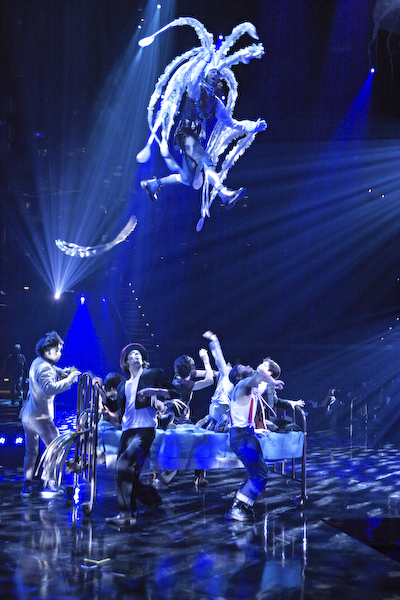
A scene from Love
Filled with some of the famous characters from The Beatles songs, featuring dozens of Cirque performers of all ages prancing in colorful and evocative costumes, accompanied by the iconic music that has circled the world over the show was wistful and lively.
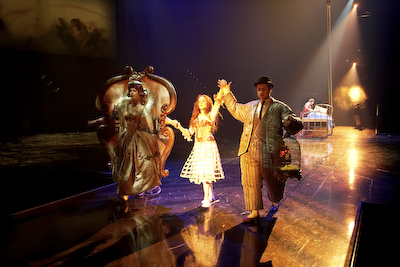
A scene from Love
In 1984, Cirque du Soleil was a group of 20 street performers; now it’s a major international organization that has provided high-quality artistic entertainment to more than 70 million spectators in close to 200 cities on five continents. In Las Vegas, Cirque du Soleil has a partnership with MGM Mirage to create and present productions. In addition to Love, visitors can try Mystère at Treasure Island, “O” at Bellagio, Zumanity, the Sensual Side of Cirque du Soleil, at New York-New York Hotel and Casino, KÀ at MGM Grand, and Criss Angel Believe at Luxor. Click here for an article about Love.
by Editor | Mar 30, 2009 | Books, Luxury Travel
Article by Elena del Valle and photos by Gary Cox
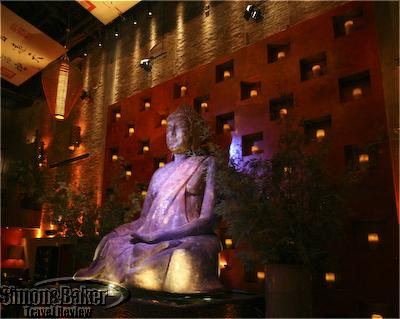
Tao buddha
Except for the near empty state of the large restaurant (we arrived in the late afternoon) it would have been hard to tell what time of day or night it was inside Tao Asian Bistro (3377 Las Vegas Blvd. South, Las Vegas, NV 89109, +1-702-388-8338, Taolasvegas.com). Such was the style of the nightclub and bistro which could accommodate 2,000 guests. Located at The Venetian Resort-Hotel-Casino, the two-story restaurant was crawling with shadows that made it appear mysterious. Done in a slightly different way it could have felt soulless but bright shades of red, brick walls, kanji characters reflected on the ceiling and larger than life decorative oriental artifacts lent it a certain magic. It had the air of a place that comes alive with patrons, especially in the evening.
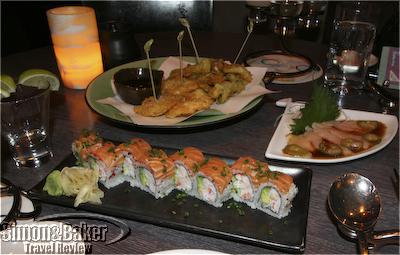
Tao appetizers
The hostess led us to the last booth, tucked away next to the kitchen door and across from a giant Buddha. Chris, our friendly and knowledgeable server, was with us moments later. At his suggestion, we tried two martinis: Tao-tini (Absolute Mandarin, Stoli Rasberry, Malibu Rum, cranberry and fresh lime juice) and a Lychee Martini (Ketel One, Triple and fresh luchee puree). For starters we shared the Yellowtail Sashimi with Jalapeño and Ponzu Sauce (a favorite); Alaskan Salmon, Crab and Avocado Roll; Kimchee and Baby Shanghai Bok Choy with Garlic.
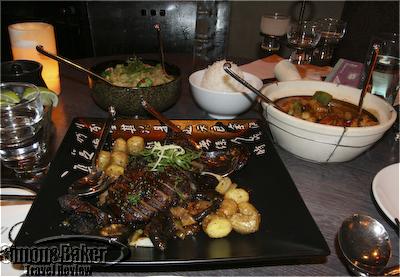
Wok Seared New York Sirloin with Shiitake Mushrooms and Szechwan Potatoes
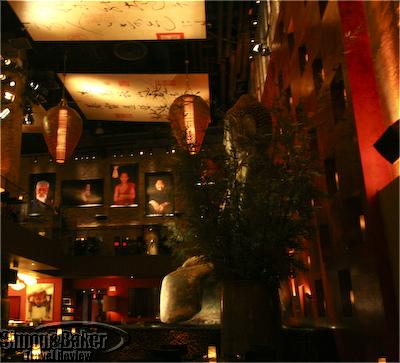
View of the Tao dining room from our seats
Then, our main courses arrived, a mountain of tasty food: Satay of Chilean Sea Bass with Wok Roasted Asparagus (a favorite); Lobster Wontons with Shiitake Ginger Broth; Sandpot Lobster, Shrimp and Scallops with Black Bean Sauce; Wok Seared New York Sirloin with Shiitake Mushrooms and Szechwan Potatoes; Jasmine White Rice, and Mandarin Sizzled Fried Rice with Duck. Chris recommended an ice cream dessert which we enjoyed. These culinary creations were the work of Mark Andelbradt, Tao’s executive chef, and Koji Noda, the executive sushi chef, and their staff.
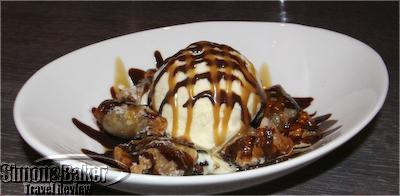
Our dessert
We washed it all down with six types of sake (Chris recommended this) including three “crazy fun” ones. He brought us the Spirit and Eternal selections from the sake by the glass menu. As we headed to our show (that’s why we arrived so early), the thought occured to me that although we sampled lots of savory dishes and drinks we would were pleasantly satisfied. We had a fun and enjoyable dinner at Tao.
by Editor | Mar 9, 2009 | Ecotourism, Luxury Travel, Products
Article and photos by Gary Cox
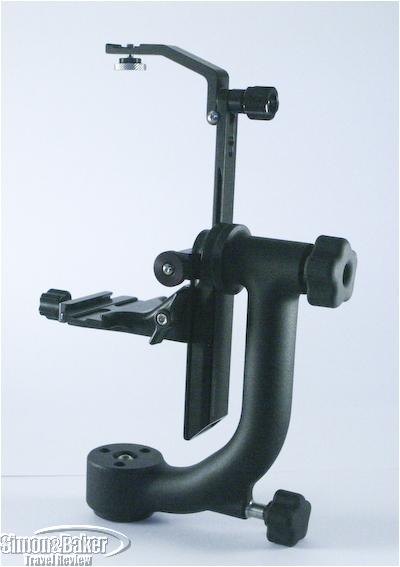
The Wimberley Head Version II
While on safari in South Africa last year, a ranger who was a fellow photographer, introduced me to the Wimberley Head. Mounted on a standard super clip, this piece of equipment revolutionized my game viewing photography. The super clip securely holds my 100-400 millimeter telephoto lens comfortably mounted onto the bars on the Land Rover or other game viewing vehicle. The telephoto lens is fitted with an Arca-Swiss style plate purchased separately from Wimberley.
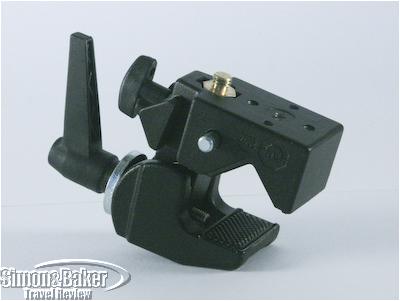
The Super Clip with Tripod Screw Head
The Wimberley tripod head uses a gimbal-type design to balance the camera and lens in all three dimensions. This greatly reduces the strain and potential shake of using it free hand, and the flexibility of movement is a big improvement over bean bag solutions I have tried. It is well engineered, with a solid feel, easy to use adjustments and clean lines. One notable issue, because it is mounted on the vehicle, other people moving around can cause the vehicle to shake, which can be quite annoying at the wrong moment. It is best suited for private to semi-private game drives because the camera extends over the seat in front of the photographer.
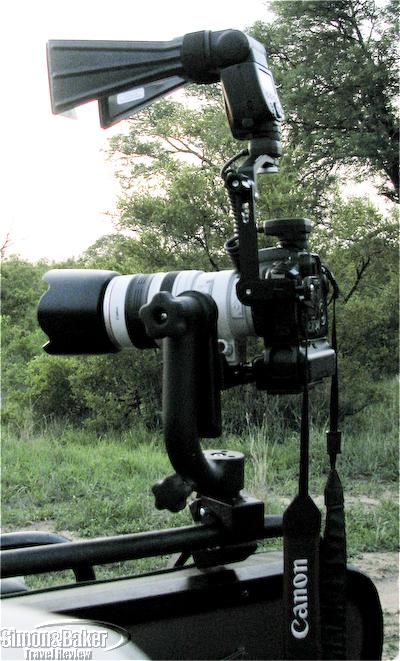
The full rig in the field
The photo above shows the full rig, including the external flash mount bar (sold separately). The flash extender completes the telephoto game viewing setup. This configuration, combined with the lens’ image stabilization, provides a great platform for wildlife photography, reducing the annoying windows of downtime in the early morning and late evening when some of the best viewings occur, but the light is too low for a telephoto shot. When the vehicle is moving from sighting to sighting, the flash unscrews from its mount with a thumb wheel and the clamp releases the plate on the camera to avoid shaking the equipment apart on the dirt roads.
The Wimberley Head travels with me whenever the telephoto lens is in the bag. It is now an indispensable element of my camera support equipment.
Wimberley, located in Winchester, Virginia is a small business owned by a father and son team, David and Clay Wimberley, both mechanical engineers dedicated to designing and making professional photography equipment. The company offers a 60-day unconditional money-back guarantee on all of its products and has loaners available through its Free Trial Program. For details visit Tripodhead.com
by Editor | Feb 23, 2009 | Luxury Travel
Article and photos by Josette King
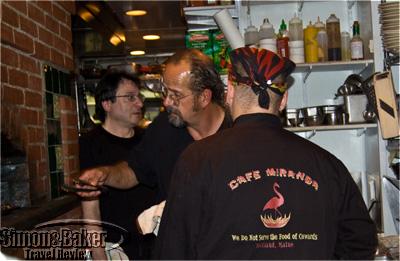
Chef Kerry Altiero retrieves a dish from his brick oven
“I don’t fancy a power struggle with my food,” my friend said as I was vaunting the merits of fresh-off-the-boat and right-out-of-the-pot Maine lobster. She was a Southerner whose sole experience of The Northeast was a long ago visit to New York City. Now that I had lured her to a girlfriends’ week-long vacation in Rockland, Maine, with promises of grand Victorian homes lovingly restored into luxury country inns, boating excursions to picturesque lighthouses along the craggy coast and a flourishing artistic life around the Farnsworth Art Museum and the many nearby galleries, I was not about to be stymied by a hard-shelled crustacean! “Forget lobster then. The town is full of good restaurants of all kinds,” I temporized, mentally crossing my fingers. I needed not be concerned. This quaint little seaport of 10,000 residents turned out to be a treasure trove of exciting eateries.
Although they differed broadly in cuisine and atmosphere, our favorites turned out to have some significant commonalities: all were chef-owned, with high-quality menus based on locally-gown organic products and freshly harvested seafood, and moderately priced to boot. Following is information on three restaurants we liked.

Café Miranda sign
Café Miranda
15 Oak Street
Rockland, Maine + 1 207 594-2034
With its 85 items menu, more than a few with impossibly kitschy monikers, Café Miranda (named after Chef Kerry Altiero’s beloved pooch) was not for the timorous, or the indecisive. As soon as I got past the veneer of irreverence of the menu (and the startling Elvis museum restroom) it became clear that it was not the entertainment value that had packed the place on a Tuesday night. Chef Altiero was serious about what got onto the plates: the freshest local ingredients, roasted or grilled in his kitchen’s wood-burning brick oven or sautéed to perfection before being rushed to the table. Many of the offerings had their roots in comfort foods of Italy, Poland and Lithuania that young Kerry had enjoyed, growing up in the 1960’s in a melting-pot community in the hills of Pennsylvania. This self-taught food artist then worked his way up the eastern seaboard, broadening his knowledge of ethnic and regional cooking along the way, to integrate it all into an imaginative culinary style that defied categorization.
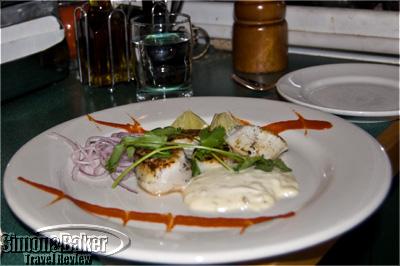
Café Miranda’s Seared Sea Scallops with green chili tartare sauce
My appetizer of Seared Sea Scallops, their sweetness enhanced by the bite of a green chili tartare sauce was a delight. So was my friend’s main course of herbed veal and pork Uptown Meatballs in a creamy shallot, garlic and Marsala sauce (we shared). We had reserved ahead to sit at the bar, where a handful of seats offered a full view of the frenetic action in the pocket-sized kitchen. The woman next to me volunteered that she was a long-time patron. “Did you try the “Pirogies”? She asked, tactfully nodding at her own appetizer while eyeing my main course of grilled baby tomatoes and fresh crabmeat. We exchanged forkfuls. The classic Polish potato and cheese concoction was livened up with sauerkraut and cranberries. Our respective friends got into the act and our meal became an impromptu tasting menu; every dish original and delicious. With its unpretentious, beautifully prepared food, friendly service and relaxed atmosphere, I plan to revisit Café Miranda anytime I find myself in Rockland again, and work my way down its imaginative menu.
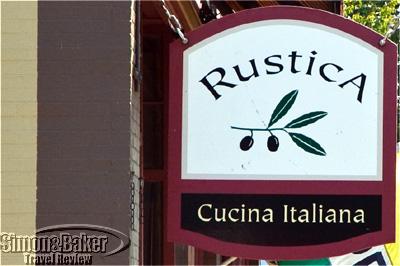
Rustica sign
Rustica
315 Main Street
Rockland, Maine. + 1 207 594-0015
Located in one of the century-old storefronts that lined Main Street, with its aged wood floors, taupe and burgundy walls and profusion of green plants, Rustica was a cheerful, timeless eatery that welcomed its guests to lovely Italian classics. While Chef John Stowe’s menu featured a few of the mandatory pizzas and pasta dishes, I happily ignored them in favor of more original offerings such as Grilled Asparagus appetizer (wrapped in prosciutto and delicately drizzled with white truffle oil and freshly grated parmesan).
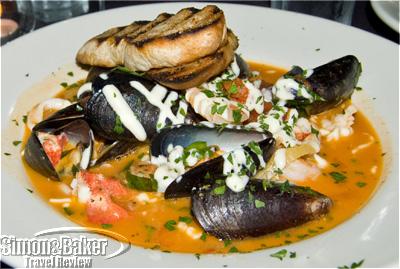
Rustica’s Sicilian Fish Stew

Rustica’s Tiramisu
I followed with a Sicilian Fish Stew, a symphony of roasted haddock, lobster, shrimp and calamari simmered in a tomato fennel broth with a touch of orange and saffron. It was topped with steamed mussels, served with grilled Italian bread and lemon aioli that made me forget that I was not in a Mediterranean fishing village. One look at the sinfully rich Tiramisu robbed me of the willpower to pass on dessert, although I was willing to trade a few spoonfuls of it for some of my friend’s equally tempting crema brusciata (Italian for crème brûlée). Rustica did not take not take reservations, but although it was quite busy on the night of our visit, we were seated promptly. Had a wait been necessary, the sprawling bar against the back wall appeared to be a popular place to enjoy a drink while waiting for a table.
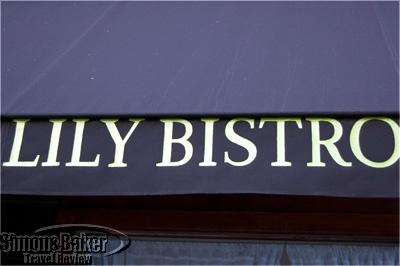
Lily Bistro sign
Lily Bistro
421 Main Street
Rockland, Maine + 1 207 594-4141
I grew up in a world were charcuterie was often home made, so any menu that boasts Charcuterie Maison as its opening line gets my attention. Lily Bistro, the recently opened brainchild of chefs Lynette Mosher and Robert Krajewski (who have been a team since they met at Johnson & Wales University in the late 1990’s) was such a place; and its charcuterie plate attention-worthy. I loved the coarse pâté de campagne and smooth duck rillettes served with a wedge of artisan cheese, crisp cornichons and crusty baguette.

Lily Bistro’s Chicken Grand Mere
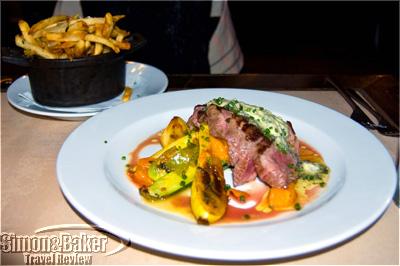
Lily Bistro’s Steak Frites
It was a suitable prelude to the delectable rustic French fare that followed. My Chicken Grand-Mère, roasted to perfection, was served over velvety puréed potatoes and tiny crisp green beans, with a ragout of chanterelles. It was worthy of my own grand mother’s cooking. The Steak Frites was a medium rare pan-seared steak topped with basil butter. It was served with a garnish of sautéed summer squash and chipolini onions and a small cast-iron pot overflowing with garlic French fries; an unconventional but excellent combination. This was honest bistro food, simple but flawlessly prepared from the finest ingredients. At the time of my visit, Lynette officiated in the kitchen, while Bob managed the dining room. From the number of patrons that he greeted by name, Lily Bistro, although it had been opened only a few months, had already developed quite a following.
Click here for more information about my visit to Rockland, Maine and its Victorian country inns, Berry Manor Inn, Captain Lindsey House and LimeRock Inn.
by Editor | Feb 9, 2009 | Accomodations, Audio, Ecotourism, Luxury Travel
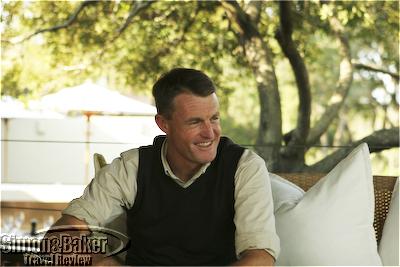
Nicholas More, co-owner, Lion Sands Private Game Reserve
While in South Africa, one of our teams stayed at 1933, an exclusive rental villa within the Lion Sands Private Game Reserve, part of the world famous Sabi Sand Reserve near http://simonandbaker.com/kruger. They liked the property and as a result of their visit we published an dedicated feature on 1933 a few weeks ago. During the visit Elena del Valle had an opportunity to chat with Nicholas More, co-owner and operations director, Lion Sands Private Game Reserve about 1933 and the Lion Sands Private Game Reserve.
Click on the play button below to listen to their conversation.
































